E.C. Ambrose's Blog, page 8
April 17, 2016
Kylo Ren and the Question of Parental Succession
Star Wars: The Force Awakens recently came out on video, so I gave it a second viewing. This blog will contain spoilers. you have been warned.
One of my favorite elements of the film centers on that scene spoiled for so many (and objected to by many others) when Kylo Ren kills his father. It comes toward the end of the film, after a moment when you (and Dad) think that Kylo may be convinced to return to the light side. He describes himself as torn, struggling with that last thing that will galvanize his future. It is, of course, killing his father.
One of the main criticisms of this film has been that it’s basically a re-hash of the first movie where the elements are mixed together, with some new characters and some old ones, and I basically agree. But I did appreciate that the film also, in revisiting Star Wars: A New Hope also goes back to the source material–namely, the heroic mythology that influence the story. If you read many fairy tales or fantasy novels, or see many Disney films, you will find that there are many, many orphans.
Mythologically, metaphorically, and often historically speaking, in order for a child to have an adventure, their parents must be gone. This is what allows the child the necessary autonomy to go forth and take risks. With the parents around, it’s usually the parents’ job to, say, save the world, confront the evil or make the sacrifice. When they are gone, the child not only has the freedom to make these big choices, but may, in fact, be obligated to do so.
This is the moment when the child becomes an adult. They can no longer hide behind their parents’ choices, go running to their parents for help, or count on someone else stepping up to take care of things. The child is now in command. Liberating and frightening, by turns. The child must take on adult roles and responsibility.
In historical terms, the parent must die for the child to rule, and many stories stem from the way things go wrong if this is not the case. Either the child rebels against the father, committing murder in order to bring about an early succession, or the father abdicates in favor of the child, suggesting that there’s a problem with the traditional order of society (King Lear, anyone?) or perhaps the natural order of the world.
Parents speak of leaving a legacy in their children–in the desire for the child to be better off, more powerful, more wealthy than they have been–wanting the child to exceed their own lives. And governments speak in terms of the “replacement rate” for births, in which the expectation is the parents die off, but have left enough children behind for society to go on. Family businesses have the hope if not the expectation of children who grow up to take their parents’ place at the helm, whether that is a family restaurant, a laundry shop, or a political dynasty. In spite of all the changes in our world from the era of royalty until now, this sense of the child eventually rising to take on the adult’s role of leadership is considered by many to be part of the natural order.
So of course Kylo Ren could not move forward with his goals and ambitions while his father lived. He needed both the emotional freedom that comes from decoupling the child from his past (gaining orphan status, with which to go forth on his adventure) and also the dynastic sense of succession, becoming a general in his own right–although for a very different cause than the one his father supported. He tells his father that he needs only one thing in order to move on, and Han Solo, being the good hero and devoted dad that he is, delivers it: his death.
I wonder what would happen in a more mythically aware version of the scene in which a father, realizing what the son requires, chooses to deliver it by killing himself. . .


April 8, 2016
Unused Settings: Aachen, the Imperial City of Germany
I’ve mentioned Aachen in a couple of recent blog posts, and I figure it’s time this beautiful city got its own entry although, alas, it will not appear in my book.
I had the opportunity to visit a couple of years ago on a research jaunt aimed at making my series “more epic,” ie, wider in scope and scale, by expanding beyond England, and in the final two volumes you’ll see the result of that effort (and hopefully love it).
Aachen is the westernmost city in Germany, sharing a border with Belgium and the Netherlands, on the Rhine river. If you have the chance to go, I highly recommend taking a river cruise or taking the train to get there. The entire length of the Rhine is studded with spectacular castles.
Charlemagne visited for the first time in 768, after his coronation as King of the Franks, and began spending all of his winters there (his down-time between seasons of war or or official travel), making it the center of his court. While he does not appear to have added much to the fabric of the city, he did build his Palatine Chapel (now the cathedral), a sumptuously decorated central plan church, which houses his striking throne.
The striking part is, of course, how plain it looks: made of just a few slabs of white marble, with wooden doors to cubbies underneath. But this throne has its own story. Those slabs of marble and the steps leading up to them were taken from the Church of the Holy Sepulcher in Jerusalem. And the cubbies underneath? During the coronation, the jeweled and gilded Purse of St. Stephen would be placed inside. This holy relic enclosed dirt from the place where St. Stephen was martyred. So when a king of Germany sat here, he was symbolically seated in Jerusalem, the center of the world. Charlemagne had already been crowned, but the throne still held a great deal of significance.
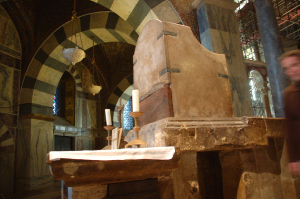
Throne of Charlemagne
In the nearby city hall, you can take a marvelous audio tour, which includes a nifty interactive component that makes you a witness to the coronation of a later king, with commentary by everyone from merchants to servants to nobles who might have been present at the event. I was a little irked that, in the audio tour, they did not fully explain the imperial regalia, replicas of which occupy a nice glass case. You can see a version of the Purse of St. Stephen here, along with the Iron Crown (which contained a nail from the Crucifixion–okay, one of many nails made from a nail that theoretically came from the Crucifixion) and Charlemagne’s sword. However, the audio does not explain the significance of these artifact/relics, nor does it even mention the lance: said to contain a fragment of the very lance that pierced the side of Christ.
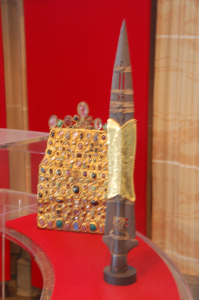
the Purse of St. Stephen, with the Holy Lance
In Aachen, the enthusiast for medieval history can thus discover how the secular powers sought to claim the imprimatur of the heavenly power with every bit of stone and soil.


March 31, 2016
Crowned with Legitimacy: Recognizing a Ruler
Here in America, we are in the throes of a presidential election cycle (you may have noticed. . .) If one of the candidates sweeps up a large majority of the popular vote in November, that leader will be said to have a “mandate”: the backing of so many people that their leadership will afford the chance for sweeping change. Without that mandate, the president will be expected to scale back on campaign promises, to work hard for compromise (wouldn’t it be nice if they did so anyway?) and to be cautious about public polling taking a nosedive.
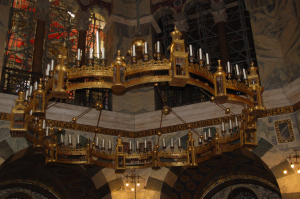
the “corona” or crown chandelier at Aachen cathedral
My blogs on the competing Holy Roman Emperors got me thinking about this process of legitimizing a ruler. HRE Louis was crowned at Aachen, the capital established by the Empire’s founder, Charlemagne, but not by the traditional archbishop, nor was his throne ever recognized by the pope, so his grip on power was tenuous at best, and he and Charles struggled to gain more of the electors to their side in order to claim that legitimacy.
In my novel, Elisha Rex, I have a totally unexpected candidate for the throne of England, based on the power of “laying on of hands,” which was said to be a royal sign, and certain other acts perceived as miraculous–showing that the new monarch had been anointed by the Lord. This recognition, in the book, comes from the Archbishop of Canterbury, the prelate of England, and the man who had the authority to crown the king, all signs that lend an air of legitimacy to the unorthodox ruler.
In China, there is a long tradition of the “Mandate of Heaven,” the idea that the celestial bodies, representing the deities, have given their blessing to a particular reign, typically an imperial dynasty, somewhat similar to the idea of the king being “God’s anointed.” If a challenger succeeded in overthrowing the current dynasty and establishing a new one, the it was clear that the Mandate of Heaven had passed to the new ruler. Sometimes, this meant presenting or claiming signs of that legitimacy: portents that would indicate the shift in celestial backing, like finding a message in the belly of a fish, or claiming miraculous birth, as did Liu Bang, the peasant-born founder of the Han dynasty.
Interestingly, the Mongols, who rose from the neighboring steppes under Chinggis Khaan, also perceived themselves as having the Mandate of Heaven–in their case, the Eternal Blue Sky–to spread across the lands all the way to the sea, and every victory they won seemed to legitimize the claim. But their great khan still required a vote of support from their followers–a sort of hybrid system between the Mandate of Heaven, and the will of the voters.
What will happen in November? At this point, it’s hard to say–but whoever wins will almost immediately begin to look for the markers of legitimacy, even if they fall short of claiming healing powers or heavenly intervention.


March 25, 2016
Relics in the Middle Ages: The Crucifixion
In honor of Easter, which many folks will be observing this weekend, I wanted to look a little more deeply at the role of relics in the Middle Ages. It’s no secret that medievals were a little mad for relics. They bought, sold, and traded them, used them as marriage or coronation gifts, and carried them as souvenirs of important visits or as talismans to maintain a close connection to a saint. Many people could not afford a “true” relic, of course, but they could have handkerchiefs or other bits of cloth, or an ampula of water from the holy destination–or even, from the water said to contain the blood of St. Thomas a Beckett. Naturally, the exchange of relics was theoretically against Church doctrine, but a gift could be given, for a certain financial consideration. . .
There are several orders of relics, from the actual flesh or bones of the saint, to things that they touched or used. The most important relics in the Catholic Church are those associated directly with the Holy Family: the girdle and tunic of the Virgin Mary (not to mention some drops of her milk, and her tears) are carefully preserved in cathedrals in Prato, Italy, and Chartres, France respectively, and there is even a church which claims to have her tomb.
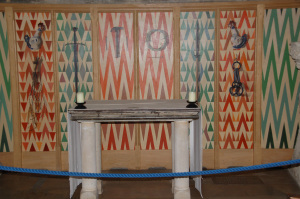
A chapel at Ely Cathedral, England, dedicated to victims of torture displays the “regalia of Christ”, including the crown of thorns and scourge
But the central figure of the Christian narrative, Jesus Christ himself, presents a bit of a problem from the standp0int of the obsession with relics. Because, according to Christian doctrine, he rose bodily into heaven after his resurrection, you can’t have first-order relics. Well, save one. . .and that would be the holy foreskin (officially known as the Holy Prepuce). Possibly the world’s most embarrassing relic, but also the only bit of flesh from the Messiah to remain in the earthly realm. If you are curious about it, I highly recommend David Farley’s book, An Irreverent Curiosity: In Search of the Church’s Strangest Relic, in Italy’s Oddest Town.
So the faithful are left with other kinds of relics. The Shroud of Turin is certainly notable, but didn’t arrive on the pilgrimage scene until the 14th century, and may have been a fabrication intended for that very purpose–pilgrimage was big business in the medieval period. Charlemagne claimed to have the lance which pierced the side of Christ, and it was said that whoever held the lance could not die. The crown of thorns can be visited in France, but of course some thorns have been broken off and distributed to other churches or monarchs.
We owe the presence of the earliest of these relics, the cross itself and the nails that pierced it, to the persistence of Saint Helena, Constantine’s mother, who, after her son embraced Christianity, journeyed to the Holy Land in search of relics to display the new faith to the Roman Empire. All I can imagine is that the local guides saw her coming. . .over three hundred years had passed since the Crucifixion. Nevertheless, she found not only a substantial chunk of the True Cross, but also the plaque placed with it. The largest part of the cross now resides in the church at Rome that bears its name.
Nails are another matter. Were there three? or four? Different artists depict different numbers, and archaeological evidence suggests there may have been only two for the feet, while the arms were bound with rope instead. In any case, there certainly weren’t seventeen, in spite of medieval claims on behalf of various nails around Europe. There are currently thirty different places claiming to have parts of the nails (and 50+ hits on e-bay for “crucifixion nails”, though none claiming to be actual relics) Helena had the nails she brought home melted down and cast into new nails so they (and their holy power) could be more conveniently shared. One of them was made into a bridle for Constantine’s horse. Another became part of the Iron Crown of Lombardy, which may have been used to crown Charlemagne, among others.
It’s important to remember, in all of this apparent dealing of relics and bits of the saints, that what people truly wanted–then, as now–was the sense of holding close to something greater than themselves, drawing inspiration from those they perceived as holy.


March 20, 2016
Review: Magic, Mysticism, and Hasidism, by Gedalyah Nigal
I picked up this book after discovering it in the bibliography of a couple of other books on Jewish mysticism which I was reading as research material for book 4 in my Dark Apostle series. I wanted more detail on some of the apparently magical powers of certain rabbis and sages, which are relevant to my fantasy novels, and this book delivered.
The book is broken into sections with intriguing subject areas like intermarriage with demons, dybbuks, and kefitzat ha-derekh (“bending the way”–a means of extremely rapid travel used by the righteous). each section then gives numerous examples from both folklore and rabbinical history where these subjects cropped up. It places the examples in chronological order, which is very handy for me because I am focusing on the 14th century, and references much after that are less useful. The book also includes a lengthy section of notes in the back which are easily found (the tops of the pages tell you which page in the book are covered by those notes–why don’t more books do this??)
My first complaint is the lack of context for some of the names. The book assumes a good knowledge of the Jewish sages, by name, place and dates, because it rarely bothers to pin down these details in the text. Without that knowledge, I was sometimes lost and had to cross-reference the names in order to identify the time and place origin of the stories being related. It doesn’t help that the author, while primarily working in chronological order, will occasionally refer to contradictory opinions of scholars from later eras. This makes for a nice mishnah effect with overlapping commentaries, but from an academic standpoint, is a bit dicey.
Also, some subjects did not appear, like the concept of the lamed-vov, the thirty-six righteous ones who are guardians of the Jews, driven by compassion, and without whom the world might be allowed to end.
However, if you are interested in Jewish mysticism, this book contains all kinds of goodies. For the areas the book covers in detail, it is much more engaging than other works I have read. I had not previously found references to kefitzat ha-derehk being used on the water, but a couple of the wonder-workers here sped their boats by use of holy names written on the bow or sails, or understood that the term “golem” might be applied to a soul-less body in general (ie, a corpse re-animated after someone has died), not just a created being as we usually see it applied.
Still haven’t figured out the new system for sending my Goodreads reviews over here, but if you’d like to read more of them, you can find my reviews here.


March 11, 2016
The Two Emperors: part II, Charles IV
At the end of the first part of this blog, I noted that Charles IV could not have been more different from his rival, Louis the Bavarian. Charles, born 1316, was 34 years younger, handsome and affable. He was highly educated, and spoke several languages. He also has the distinction of being the first ruler we know of to have penned his own autobiography. It’s fascinating to be able to learn about a medieval figure not from the historical record of deeds and battles, births and deaths, but from his own hand–and the more so when his account of himself seems to accord so well with his recorded legacy.
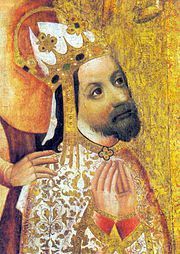
Charles IV, King of Bohemia, and Holy Roman Emperor, 1346-1378
Charles (born as Wenceslaus, a point we’ll come back to later) was the eldest son and heir of the King of Bohemia, who died in the famous Battle of Crecy, in August, 1346–one of the seminal English victories of the Hundred Year’s War between England and France, and one which drew in many of their allies. Charles was also present at Crecy, but managed to escape with his life.
When his father died and Charles assumed the throne of Bavaria, he shed the name Wenceslaus and chose the reign-name of Charles to honor his patron, Charles IV of France (yes, this is where the names become very confusing) in whose court he fostered for seven years. By that point, Charles had already been elected as Holy Roman Emperor in opposition to Louis the Bavarian–primarily at the instigation of the new Pope Clement VI. In spite of growing concern about Louis’s scheming, the German electors did not truly support Charles because they felt he was under the thumb of the French, and had conceded too much to the Pope in exchange for his crown. He was often referred to as the priest’s king as a result.
Charles worked hard to solidify his rule, making Prague his capital and founding a university there which became a center of learning and culture. All of Europe was rocked by the advent of the plague which we know as the Black Death, but was, at the time, referred to as the Great Pestilence. After Louis’ death,another emperor, Gunther von Schwartzburg, was elected, but gained little support and died soon after–possibly with the collusion of his physician.
Charles was officially re-elected, this time with greater support, in 1349, and crowned at Aachen, the symbolic heart of the empire. During his reign from Prague, Charles received letters from the poet Petrarch, who hoped to convince the HRE to move his seat of power to Rome and revitalize that damaged city. Charles also received a visit from the once-and-future Tribune of Rome, Cola di Rienzi, who pleaded for his support in re-claiming the city. Charles promptly arrested Cola and had him imprisoned, then shipped to the pope to face charges instigated by his brief, mad rule.
While Louis is remembered as divisive in both church and state, Charles IV lead an era of prosperity, culture, and relative peace within his boundaries until his death in 1378. And for those of you still wondering about that name, at the back of Charles’ autobiography, you can also find his Life of Saint Wenceslaus, his namesake and holy patron–and the man who inspired the Christmas carol, “Good King Wenceslaus.”


March 5, 2016
The Two Emperors: part I, Louis the Bavarian, the Man who Named his own Pope
During the period when the Dark Apostle novels are set, much of central Europe was consolidated as the Holy Roman Empire (which the wags are fond of pointing out was neither holy, nor Roman, nor an Empire–all valid points, but a bit outside my purview). The post of emperor was voted on by a group of electors, primarily noble land-holders, but also a few bishops, but the 14th century was marked by the unusual overlap of two different elected emperors–one of whom refused to leave office. This profile will focus on Louis IV, called “the Bavarian” while my next takes a look at his rival, Charles IV.
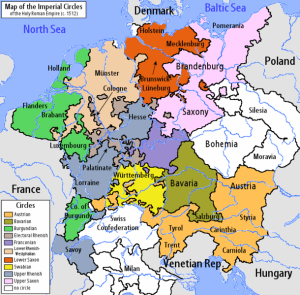
a map of the Holy Roman Empire showing areas controlled by the various rulers
Louis, the hereditary duke of Upper Bavaria (b. 1282), inherited several other titles on the deaths of various relatives, leaving him King of the Romans, Duke of Bavaria and King of Italy. Louis reign as emperor sort of began in 1314, but he’d been elected by only one faction of the electors, with the others supporting, Frederick, the son of a former emperor. Both men quickly had themselves crowned (Louis at the customary seat in Aachen, where Charlemagne had his throne) but not by the customary archbishop, leading to several years of war.
Louis eventually prevailed, taking his rival prisoner, and only releasing him under pressure from the Pope, and with the promise that Louis was proclaimed the rightful emperor (HRE). Frederick so impressed Louis with his chivalry and honor, that Louis offered to reign jointly with him, an arrangement that the other electors vetoed, leaving Frederick as a subsidiary king, and apparently satisfied.
But Louis and the Pope never fully mended their relationship. At the time, these were the two most powerful roles in all of Europe, and Pope John XXII never fully accepted the legitimacy of Louis coronation. To truly claim the throne of the empire, Louis should be crowned in Rome–but Rome was kind of a mess at the time. As tension mounted between the HRE and the Pope, the pope finally excommunicated the emperor in 1324, a punishment that had often brought an emperor to heel in the past. John had apparently reckoned without the Louis’s forceful personality.
Louis won through to Rome, where he cowed the clergy, and had himself crowned by one of the senators, after which he declared the Pope a heretic, and set about getting himself a new pope, a spiritual Franciscan who ruled as Nicholas IV, but both of them were forced to leave Rome, along with a collection of other rebel clergy, including the Englishman William of Ockham (of razor fame). The power brokering of the time forged and dissolved various alliances, usually aimed at limiting the power of the French, who controlled Avignon where the pope then lived–not Louis’ pope, but the legitimate one. Louis’s desire for greater power, land and influence eventually lead him to renounce his own pope and angle for reconciliation.
Unfortunately, Louis’ scheming and land-grabs had antagonized even the nobles who once supported him, and his excommunication meant that, as good Christians, they weren’t even supposed to have contact with him. Thus, in 1346, the electors gathered and elected a second emperor, Charles IV. Only Louis’ untimely death in 1348 broke the ensuing civil war.
By all accounts, the two emperors could not have been more different. Louis was older, and, as you may gather from his offending almost everyone, not easy to get along with. Louis married twice, and sired sixteen children including a girl named Anna, who in the real history died young. For the purposes of my own book, I have allowed her to survive her childhood and marry the fictional prince Thomas of England–another of those political matches the medieval nobility were known for. Next week–let’s talk about Charles, the emperor who won!


February 12, 2016
The Royal Touch: Laying on of Hands
One of the fun things I got to play with during my protagonist, Elisha’s unexpected rise to the throne of England in book three was the idea of the king as a healer, specifically, as possessing the royal touch, wherein the monarch could heal certain conditions by laying his hands on the afflicted. This is a historical phenomenon which apparently began with Edward the Confessor, the only English king holy enough for sainthood.
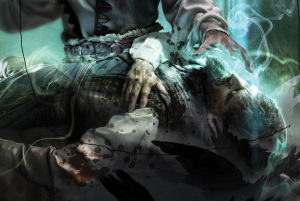
Elisha healing the prince in Elisha Magus
You may recall from J. R. R. Tolkien’s The Lord of the Rings that we are told “the hands of a king are the hands of a healer.” In that work, Aragorn, the True King in disguise uses a plant called King’s Foil (described by others as a weed) to heal when he pays a call to the Houses of Healing.
In England, the healing was more circumscribed, and applied only to a skin condition known as scrofula, or the “King’s evil”, a generic term which probably covered a variety of ailments. The primary condition often cured on its own, lending support to the idea that the king’s touch had done the trick.
The claim to have this healing touch was often used for new dynasties and rulers of uncertain legitimacy (exactly as I have used it in Elisha Rex, when a cleric witnesses Elisha’s healing of a skin ailment and perceives this as another sign from the Lord as to Elisha’s being ordained the king). Interestingly, the French monarchy also laid claim to the Royal Touch, and further tried to discredit Edward the Confessor as its originator, saying that the English only made the claim in imitation of their own Phillip I.
But the actual laying on of hands was relatively rare. In fact, the monarch often would touch a coin, and this coin would be conferred to the sufferer who would wear it, and thus be healed. When the ritual was performed directly, it would be done during the winter months, when the likelihood of the monarch receiving a disease in return was thought to be reduced.
The roots of the concept go back to the New Testament, wherein Jesus heals at various times by laying on of hands. And it continues even today, with questions like, “Was Jesus a Reiki Master?” I have some Reiki-oriented friends who tell me that the quest to recapture Jesus’ healing energy is what led to the creation/discovery of Reiki practice. From Jesus, to Edward the Confessor, to the present day, the tradition of healing touch goes on.


February 5, 2016
Exit, Pursued by a Bear: Violence in “The Revenant”
I went to see “The Revenant” this past weekend after being encouraged to do so by an acquaintance who knew the film had some relevance to my current writing project. Although I write about grim and gritty subjects, I felt a bit overwhelmed by the volume of blood and gore on the screen for this one. There will be spoilers.
I came away feeling that the director wished to express the theme that men are simply brutal to other men whenever they have the chance (and to women, too). The natives, the Americans, the French all got into the bloody thick of things. It had a very high body count for a film so focused on a single character. At times I thought of “Gladiator”, and of “Braveheart” both with notably violent heroes in violent times (both also with spectral love interests–both of which were, IMO, much better done). But I don’t recall getting splashed with the gore in either of those films, not even during the drawing-and-quartering scene in the latter.
Sometimes a film or author is accused of making bloody violence into a form of pornography. I wouldn’t say that’s the case here–the violence was not glorified, but rather so relentless that it became depressing. Because almost all of the characters in the film, regardless of race or standing, seemed willing, and at times, determined, to participate in the gore-fest, it delivered a very negative view of humanity (or perhaps simply of mankind, since most of the violence is perpetrated by and on other men, with the notable exception of a rape-victim’s revenge.)
A violent artistic work, whether it be film or novel, can be uplifting, challenging, disturbing in the end. It can leave you feeling both raw, and fulfilled, if the violence supports that kind of theme. “The Hurt Locker” has its share of gore, but it is there to both illuminate the experiences of the soldiers, and to reveal the psychological impact of violence on them (and on the viewer by extension). I have written earlier about a Chinese film, “Shaolin,” that took a very deliberate approach to violence.
In “The Revenant,” the violence seems to have no impact on the participants. They are no more hesitant (or willing) or perpetrate violence again. The deaths and maimings are never direct or what might be termed in the chivalric tradition as honorable: people are often killed while running away, they are beaten when they’re down, unarmed people are slaughtered by the dozen. The only person killed with a single blow is the protagonist’s son–everyone else requires multiple wounds.
The one clearly honorable character in the film, Captain Henry, the leader of the fur-trapping expedition, seems to exist outside of this cycle of violence, yet he, too, seems barely affected by it until he nearly succumbs toward the end of the film. One of the native characters, a Pawnee man, says that revenge is in God’s hands, and the repetition of this concept at the end might be seen as some kind of turning point for the protagonist–but the effect is the same (and there has already been an unbelievable river-side gore-fest by that point).
So am I just taking this film a little too hard? If we trimmed the actual gore seen on screen, would we end up with a different theme? Unfortunately, I don’t think that would be sufficient.
If the filmmaker had taken a more nuanced approach to the depiction of violence, as well as to when and how it is applied, the work as a whole might have had a very different effect, and these potential twin moments of transformation (the captain’s movement toward violence, the protagonist, Hugh Glass’s movement away from it) might have shone and suggested a more thought-provoking theme than simply that men will relentlessly attack each other.
I knew that vengeance was a major element in the film, but I thought, before going, that the primary thrust of the central narrative would be the protagonist’s fight for survival against the elements of nature (AKA, “man versus nature” in the parlance of your high school English class). It turns out to be almost entirely “man versus man” with a large number of the killings or attempted killings taking place between people who seem to have little reason to assault each other (the egregious and utterly predictable death of Glass’s Pawnee friend, for instance.) After his initial mauling by the bear, Glass is left in bad shape–but his natural encounters leave him none the worse for wear: not falling or grinding dirt into his wounds, nor floating for a long way down a frigid river. He has no gloves or mitts, yet he never loses a finger to frostbite–nor even seems very worried about it–he is often depicted quite far away from whatever heat source is available.
The first few scenes of him regaining motion after the mauling show him dragging a leg at a very wrong angle, but this proves to be nothing more than a sprain, I guess, because it is never splinted, and results in only a minor limp by the end. His injuries seem to heal, rather than to degrade over the course of his adventures. I’ve taken Wilderness First Aid, and done a fair amount of research on early surgery and wound care. This film *could* have been about a heroic survival against those kind of odds–if only the actual stakes of his injuries and his travel conditions had been believably presented. He comes through with the only sign of his very, very long exposure to the elements with only chapped lips (next time, go for the bear grease, Leo.)
So there is no balancing of other dangers against that of Man, no sense that the direct challenge to his survival is all around him.
And the motivations of the Arikawa tribe who follow the group of trappers from the bloodbath that opens the movie to the one that finishes it are not borne out in what they do. I found it interesting that some native voices online are praising the film, (one example) not only for its depiction of the presented tribes, but for its honest presentation of the theft of America from the native population, and the many levels of betrayal that took place to accomplish it. The author of the piece above states that it is this theme that justifies the opening battle–however, that is not how the tribe’s actions are presented in the film–this idea of a justified vengeance on behalf of dispossessed and abused natives only comes up later, and not in reference to this battle.
Instead, the Arikara are seeking the chief’s kidnapped daughter, and apparently the way they look for her is to slaughter everyone available to die, then search the bodies to see if she is there. Even if their anger against the trappers is justified, or if they are driven also by commerce motivations, the expressed motivation for the act doesn’t fit. I would assume the chief wanted her back alive, but he seems content to kill first and ask questions later. Then, when they do get her back, why don’t they simply go home? Instead, they have apparently pursued Glass or the other trappers back to the fort (and beyond), although the people who kidnapped her were, in fact, already slain by Glass himself. Vengeance has been served, but they appear at the end to give us one more thrill of danger (will Glass end up as another victim of unjustified murder?) and deliver the final blows (never just one).
The portrayal of a theme is always a bit tricky in a narrative work. Ideally, all of the elements work together–plots, subplots, character arcs, embedded stories or expressed morality–to convey the creator’s intended message. I’d have to say that the director has achieved this, it’s just a message I fundamentally don’t believe in. How about you?


January 30, 2016
Free Fantasy Story: Mari’s Garden
In lieu of a real blog entry, I offer you the following complete short story, a historical fantasy from the Dark Apostle universe. This story features the early lives of two characters featured in Elisha Magus and Elisha Rex.

a chilled English rose
Trigger Warning: this story implies non-consensual sexual relations.
Mari’s Garden
When Jerome first noticed Mari, out planting flowers by the inn her father’d bought, he hated her. It just seemed the natural thing to do, seeing as girls would grow up to be women—temptresses like Eve. At nine, Jerome was strong enough to carry butts of flour across the bridge to her father’s inn. The Lamb had been a wretched place for years, and this new keeper had notions of the bishop’s people staying there sometimes (madness, so his father said). Maybe it was that drove the keeper to what he did, a few years later, when frigid spring gave way to deadly summer, and even Mari’s little flowerbed started to lose color. Was about then that Jerome knew his father was right about Mari, too. She was growing to be a woman—like Eve.
Jerome settled the full butt of flour and banged on the door. Mari popped out, her dark eyes flickering down. “Thanks. My da’s coming.” She hustled into the yard, taking a horse from Sir Roger, who had business with the bishop pretty regular. Her skirts revealed strong calves, bits of dirt still marking where she’d been at her gardening.
The innkeeper stuck his head out. “Can’t pay now. Back tomorrow, eh?”
“Can’t do it, keeper.” Jerome squared his shoulders. “We need it now, and what you owe, or I’m to roll it back again.”
The keeper gave a sick little grin, his eyes roving back toward the stable.
“Here’s a fine bit you’ve been keeping from me—that why they call you keeper, eh?” The knight boomed, slapping the girl’s rump.
She gave a squeak, her cheeks flaming, but he put out his arm and caught hers, pulling her close, lifting her until her toes danced upon the ground. “Nobody’s plucked you yet, eh, my little flowerbud?”
“Not yet,” her father agreed, his glance darting toward Jerome. He folded his arms, and one elbow tore through his tunic.
“What’s she—your fourth?”
“Please, sir, my lord,” Mari stammered, and he set her down, but did not let go.
“Fifth,” spat the innkeeper, then he tilted his head. “What’s your interest?”
“I like a soft bed after a long ride. And I’ll pay.”
Jerome’s head shot up, Mari’s eyes squeezed shut as the knight pinched her chin in his fingers, looming over her. Jerome’s hands fisted, and the innkeeper pushed him back, holding him to the wall. “Right, then, your dad’ll get his money, won’t he?”
“He don’t want it that way,” Jerome said.
“Room and board’s five shillings, plus one for stabling.” The innkeeper gave a nod toward the horse. “But she’ll be a pound extra.”
“Please, sir,” Mari whispered, but her father cut her off.
“Hush up, you. Don’t want your old man t’starve now, do you?”
“This ain’t right, keeper,” said Jerome. “You can’t—”
The keeper’s palm slammed into his face, bowling him to the ground, blood spurting from his nose. “Go on and tell your father I’ll have his money. Sorry you had to see that, sir.”
“No need, keeper, someone’s got to have a firm hand. My usual chamber?” Sir Roger tramped into the door, towing Mari. Jerome reached out to her, and their fingers nearly touched, her eyes filled with tears. For a moment, his hand warmed with power, then the door slammed between them, and it drained away. Jerome trembled as he rose, stumbling back over the bridge, his arm pressed to his face. His father muttered, “Temptress,” then told him to go back in the morning and get that money, and Jerome curled into himself on his pallet, crying, his nose throbbing.
She knelt in the flowers in the morning, yanking off the dead leaves.
“Mari,” he whispered, and she flicked him a glance, bruises showing where the knight had grabbed her chin. Jerome reached out, but she flinched from his touch, scrambling to her feet and limping away, her arms held tight across her belly.
After that, Jerome’s face burned every time he crossed that bridge. Every time he pounded on the keeper’s door. He could not even bring himself to ask for money. He just stood there, his hands limp and useless, the tiny, witchy power he thought he felt heating up his hands, but doing nothing. She would not be touched by him. She who now suffered the hardened hands of half the laborers in town.
Next year, the rains returned, but her father did not stop. The year after, Jerome helped her run, but the keeper brought her back, and broke Jerome’s arm in the bargain, and his own da got up a thundering rage about how he couldn’t even roll out the butts now.
So he stood a few months later, when the rains had gone, only to see another brute too eager even to go inside, pass his coins to the keeper, pushing Mari down into her own flowerbed. Jerome howled then and ran again across the bridge, his hands sizzling. He wished the sky would open to smite the bastard with heavenly fire, but he slipped and fell, his barely-healed arm instead shooting bolts of agony. He lay on the bridge in the mud, hearing her cries, and he cried himself as he scrambled to his feet.
Jerome pushed himself harder and stumbled on, shoving through the gate.
She lay bleeding in the flower bed, the customer still hunched over her. From the stable, another voice called out, “Hey, up, don’t wear her out!” And two more men arrived, both taller than Jerome, both with arms more brawny than his father’s. One of them brushed him aside. “Hey, lad, wait your turn.”
“Let her go,” Jerome grated, and the two men laughed as their leader rose.
“This mudpuppy thinks that one’s his.”
Jerome leapt on the leader, shouting, “Run, Mari, run!”
But the two already had her in their hands, and the leader’s fist rapped Jerome’s head against the garden wall. He misbelieved his eyes a moment, but no—Mari’s skin turned a shade darker, matching the soil she knelt in. Then she sank between them into the earth, and vanished, her dress pooling on the ground.
“Jesus! Witch!” One grabbed for a knife, lunging toward her throat.
It slashed Jerome’s arm as he dove between. By the time he rolled, Mari was gone, her clothes in a pile left behind. Jerome’s aching head beat a rhythm as the three men cursed, but she had gone beyond their hands. Her beloved earth had taken her, beyond his power to reach. Did she feel the heat of power, did she feel. . .as he felt?
The evening smelled like a storm, Jerome’s power rumbled like kin riding home. He stretched out his hands and the clouds became his own. At last, he kissed the earth with raindrops, at last, he stroked away her pain.







